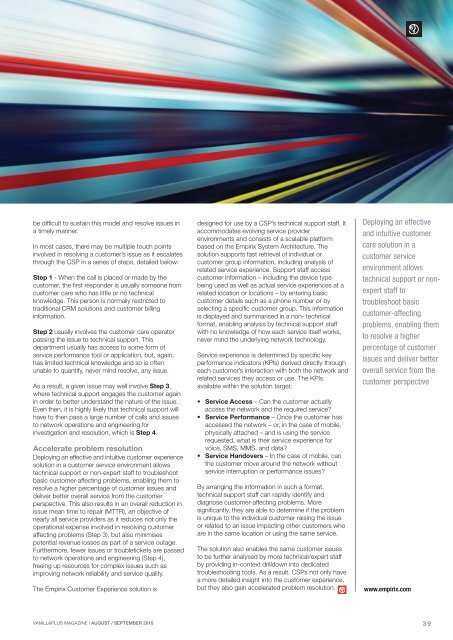CEM
1UBylUS
1UBylUS
Create successful ePaper yourself
Turn your PDF publications into a flip-book with our unique Google optimized e-Paper software.
e difficult to sustain this model and resolve issues in<br />
a timely manner.<br />
In most cases, there may be multiple touch points<br />
involved in resolving a customer’s issue as it escalates<br />
through the CSP in a series of steps, detailed below:<br />
Step 1 - When the call is placed or made by the<br />
customer, the first responder is usually someone from<br />
customer care who has little or no technical<br />
knowledge. This person is normally restricted to<br />
traditional CRM solutions and customer billing<br />
information.<br />
Step 2 usually involves the customer care operator<br />
passing the issue to technical support. This<br />
department usually has access to some form of<br />
service performance tool or application, but, again,<br />
has limited technical knowledge and so is often<br />
unable to quantify, never mind resolve, any issue.<br />
As a result, a given issue may well involve Step 3,<br />
where technical support engages the customer again<br />
in order to better understand the nature of the issue.<br />
Even then, it is highly likely that technical support will<br />
have to then pass a large number of calls and issues<br />
to network operations and engineering for<br />
investigation and resolution, which is Step 4.<br />
Accelerate problem resolution<br />
Deploying an effective and intuitive customer experience<br />
solution in a customer service environment allows<br />
technical support or non-expert staff to troubleshoot<br />
basic customer-affecting problems, enabling them to<br />
resolve a higher percentage of customer issues and<br />
deliver better overall service from the customer<br />
perspective. This also results in an overall reduction in<br />
issue mean time to repair (MTTR), an objective of<br />
nearly all service providers as it reduces not only the<br />
operational expense involved in resolving customer<br />
affecting problems (Step 3), but also minimises<br />
potential revenue losses as part of a service outage.<br />
Furthermore, fewer issues or troubletickets are passed<br />
to network operations and engineering (Step 4),<br />
freeing up resources for complex issues such as<br />
improving network reliability and service quality.<br />
The Empirix Customer Experience solution is<br />
IN ASSOCIATION WITH TELARIX<br />
designed for use by a CSP’s technical support staff. It<br />
accommodates evolving service provider<br />
environments and consists of a scalable platform<br />
based on the Empirix System Architecture. The<br />
solution supports fast retrieval of individual or<br />
customer group information, including analysis of<br />
related service experience. Support staff access<br />
customer information – including the device type<br />
being used as well as actual service experiences at a<br />
related location or locations – by entering basic<br />
customer details such as a phone number or by<br />
selecting a specific customer group. This information<br />
is displayed and summarised in a non- technical<br />
format, enabling analysis by technical support staff<br />
with no knowledge of how each service itself works,<br />
never mind the underlying network technology.<br />
Service experience is determined by specific key<br />
performance indicators (KPIs) derived directly through<br />
each customer’s interaction with both the network and<br />
related services they access or use. The KPIs<br />
available within the solution target:<br />
• Service Access – Can the customer actually<br />
access the network and the required service?<br />
• Service Performance – Once the customer has<br />
accessed the network – or, in the case of mobile,<br />
physically attached – and is using the service<br />
requested, what is their service experience for<br />
voice, SMS, MMS, and data?<br />
• Service Handovers – In the case of mobile, can<br />
the customer move around the network without<br />
service interruption or performance issues?<br />
By arranging the information in such a format,<br />
technical support staff can rapidly identify and<br />
diagnose customer-affecting problems. More<br />
significantly, they are able to determine if the problem<br />
is unique to the individual customer raising the issue<br />
or related to an issue impacting other customers who<br />
are in the same location or using the same service.<br />
The solution also enables the same customer issues<br />
to be further analysed by more technical/expert staff<br />
by providing in-context drilldown into dedicated<br />
troubleshooting tools. As a result, CSPs not only have<br />
a more detailed insight into the customer experience,<br />
but they also gain accelerated problem resolution.<br />
Deploying an effective<br />
and intuitive customer<br />
care solution in a<br />
customer service<br />
environment allows<br />
technical support or nonexpert<br />
staff to<br />
troubleshoot basic<br />
customer-affecting<br />
problems, enabling them<br />
to resolve a higher<br />
percentage of customer<br />
issues and deliver better<br />
overall service from the<br />
customer perspective<br />
www.empirix.com<br />
VANILLAPLUS MAGAZINE I AUGUST / SEPTEMBER 2015<br />
39


